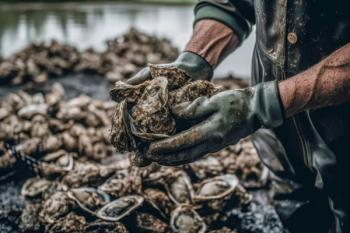Key Points
·A joint study done by scientists in Italy analyzed the nutritional and phytochemical composition of red and purple potato peels using UV-visible (UV-vis) spectrophotometry and high-performance liquid chromatography coupled with a diode-array detector (HPLC-DAD), finding them rich in polyphenols, anthocyanins, essential minerals, proteins, and carbohydrates.
·Potato peels were highlighted as valuable agri-food byproducts, aligning with circular economy goals by offering potential for sustainable reuse, reduced waste, andhigh-value nutritional applications.
·Significant variation in nutrient content across cultivars (for example, Magenta love, Blawe borge, Fleur bleue) suggests different dietary and industrial uses, with purple varieties noted for higher anthocyanin and lipid content.
A joint study conducted by the University of Sassari and the University of Cagliari (both in Italy) investigated the biochemical and nutritional composition of peels from five purple and two red potato cultivars, with particular attention to their phytochemical profiles and antioxidant properties. The total phenolic content, carbohydrates, proteins, and lipids contained in potatoes analyzed were quantified using UV-visible (UV-vis) spectrophotometry; the phytochemical composition was further characterized via high-performance liquid chromatography coupled with a diode-array detector (HPLC-DAD). A paper based on this research was published in Foods (1).
Data from the Food and Agriculture Organization of the United Nations (FAO) shows that agri-food processing industries generate huge quantities of byproducts, estimated globally at 1.3 billion tons. These byproducts cause pollution, and their disposal has resulted in a negative impact to both the environment and the economy of industries (2). Researchers have been adopting strategies to overcome this problem based on a circular economic model to promote reuse of byproducts and obtain innovative products with high added value, thereby encouraging sustainable bioeconomy growth among industries (3).
Ranked as the fourth most consumed food in the world, and with a global production of around 370 million tons per year (4,5), potatoes (Solanum tuberosum L.) are recognized for their high starch content, averaging 18% of fresh weight. Furthermore, potatoes contain substantial protein concentrations ranging from 1 to 1.5% of tuber fresh weight, while lipids represent the smallest fraction, amounting to 0.15% of fresh weight. In addition, raw potatoes are rich in essential minerals such as potassium, phosphorus, and calcium, all integral to many enzymes and playing a crucial role in metabolic regulation (6). These micro- and macronutrients are distributed not only in the pulp of the potato but also in the peel, thus representing a good source of bioactive compounds, essential amino acids, vitamins, and minerals (7).
The researchers report that theirstudy offers in-depth insights into the nutritional and biochemical properties of red and purple potato peels, showcasing their abundance in polyphenols, particularly chlorogenic acid (CGA) and caffeic acid, along with anthocyanins and essential nutrients. Purple potatoes stand out for their high anthocyanin levels, associated with various health benefits. Beyond their polyphenolic composition, potato peels are significant sources of macronutrients, including proteins and carbohydrates, as well as essential minerals such as potassium, calcium, and magnesium, all essential for human health.
The variations in nutrient composition among different potato varieties may result from genetic and environmental factors, including soil conditions, climate, and farming practices. These findings emphasize the importance of recognizing varietal differences when assessing the nutritional value of potato peels for dietary supplements and food product enhancements. Varieties like Magenta love and Blawe borge, known for their slightly higher lipid content, could be more suitable for uses requiring a richer lipid profile, while Fleur bleue presents a lighter option. Furthermore, the researchers are of the opinion that varieties with greater protein levels might be favored for human consumption or specific industrial purposes. While carbohydrate content differences among the analyzed potato varieties were noted, the analysts do not believe them to be statistically significant (1).
The researchers believe that their findings highlight the promise of red and purple potato peels as valuable agri-food by-products, encouraging sustainable nutrition practices and diminishing food waste. The diversity within the examined potato varieties exposes possibilities for developing targeted food products and high-value dietary supplements that capitalize on the health advantages of their bioactive compounds. Research like this, according to the authors of the paper, will deepen our knowledge of the potential uses of potato peels in nutrition and the food industry, supporting sustainable growth while optimizing resource use (1).
References
1. Dessì, D.; Fais, G.; Sarais, G. Nutritional and Chemical Characterization of Red and Purple Potatoes Peels: A Polyphenol-Rich By-Product. Foods 2025, 14 (10),1740. DOI: 10.3390/foods14101740
2. Gómez-García, R.; Campos, D. A.; Aguilar, C. N. et al. Valorisation of Food Agro-industrial By-Products: From the Past to the Present and Perspectives. J. Environ. Manage. 2021, 299, 113571. DOI: 10.1016/j.jenvman.2021.113571
3. O'Connor, J.; Hoang, S. A.; Bradney, L. et al. A Review on the Valorisation of Food Waste as a Nutrient Source and Soil Amendment. Environ. Pollut. 2021, 272, 115985. DOI: 10.1016/j.envpol.2020.115985
4. Gebrechristos, H. Y.; Chen, W. Utilization of Potato Peel as Eco‐Friendly Products: A Review. Food Sci. Nutr. 2018, 6 (6), 1352-1356. DOI: 10.1002/fsn3.691
5. Djaman, K.; Koudahe, K.; Koubodana, H. D. et al. Tillage practices in potato (Solanum tuberosum L.) Production: A Review. Am. J. of Potato Res. 2022, 99 (1), 1-12. DOI: 10.1007/s12230-021-09860-1
6. Navarre, D. A.; Brown, C. R.; Sathuvalli, V. R. Potato Vitamins, Minerals and Phytonutrients from a Plant biology perspective. Am. J. of Potato Res. 2019, 96, 111-126. DOI: 10.1007/s12230-018-09703-6
7. Joshi, A.; Sethi, S.; Arora, B. et al. Potato Peel Composition and Utilization. Potato: Nutrition and Food Security 2020, 229–245. DOI: 10.1007/978-981-15-7662-1_13





